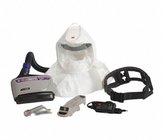I found a Versaflo TR-600-ECK system, new, damaged box, for $300. It has the soft hood but I ordered the M-307 helmet off Ebay. Total investment with shipping and tax is $775. I'm excited to put this together and try it out. Anyone have tips and tricks for assembly or use? One thought is that this comes with the vapor cartridge and spark resistant pre-filter. Will it make a difference? Do I need the particulate filter?


